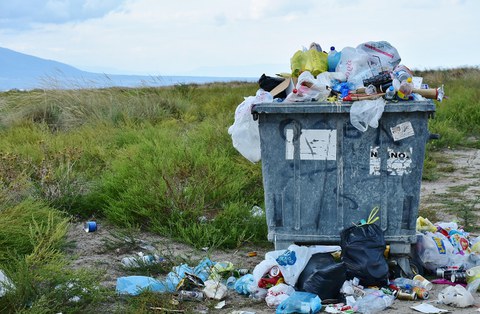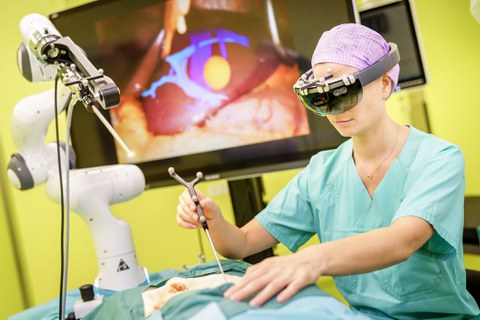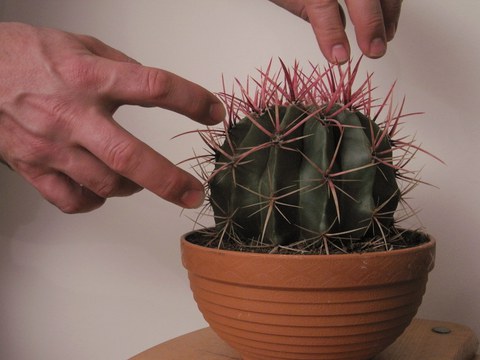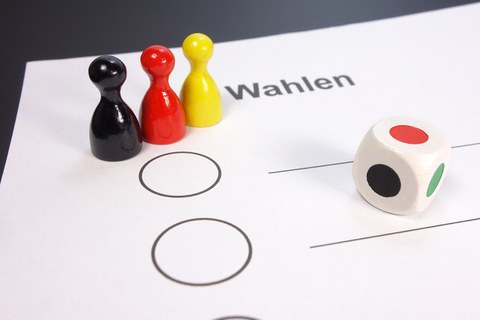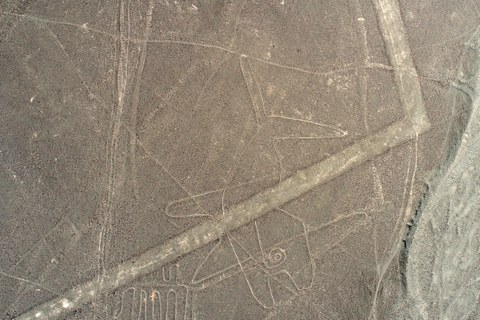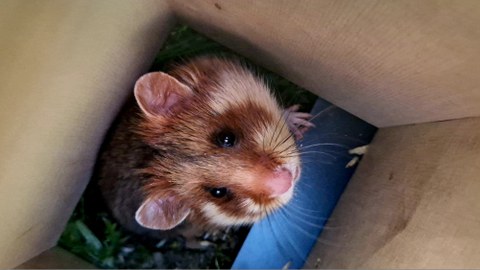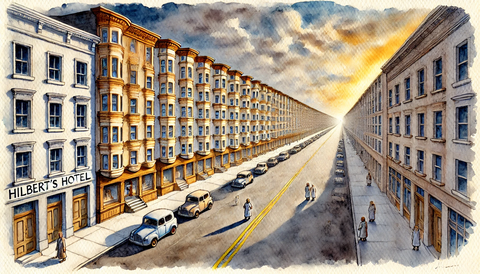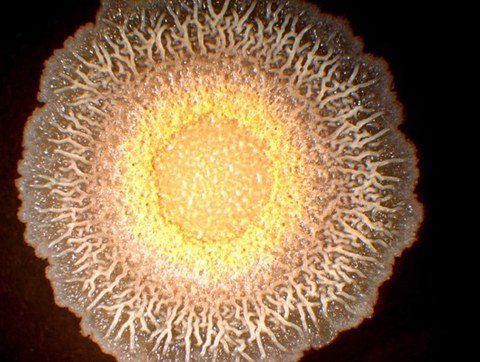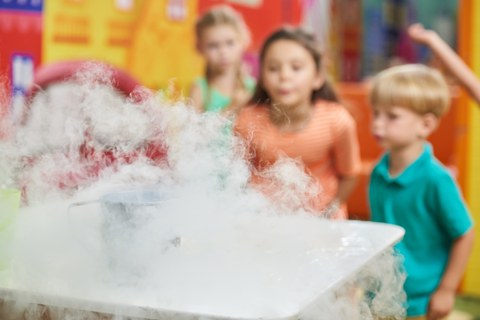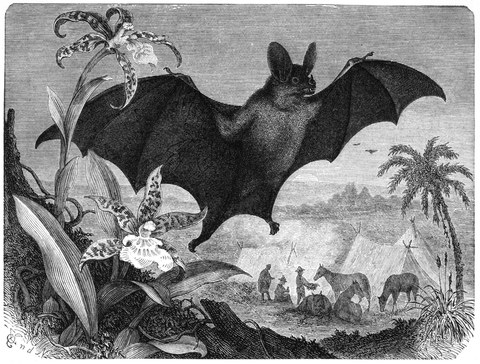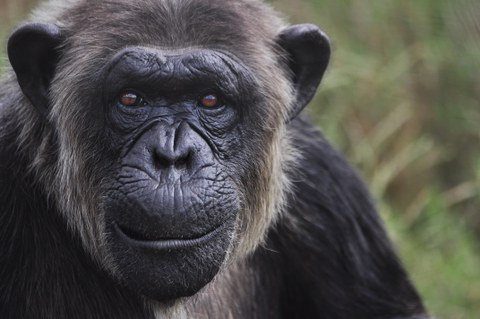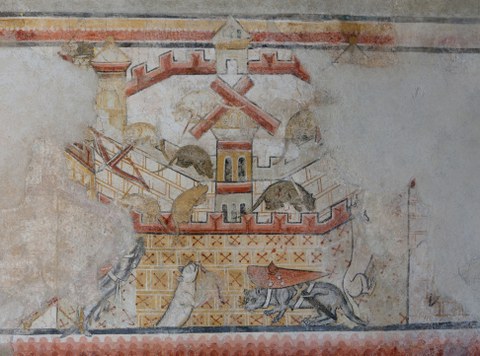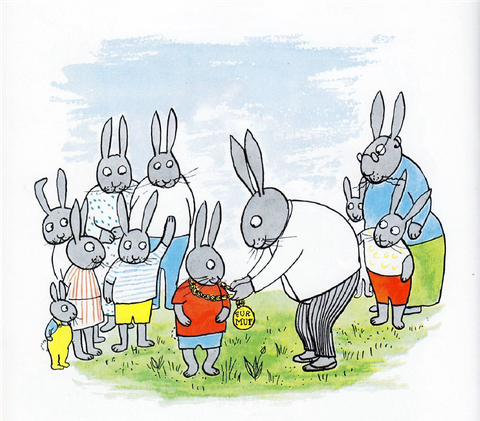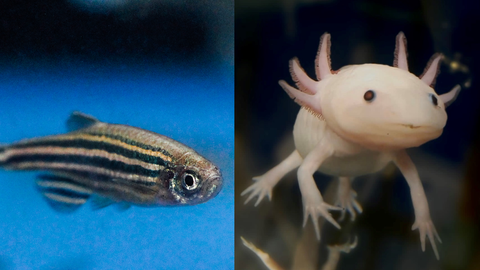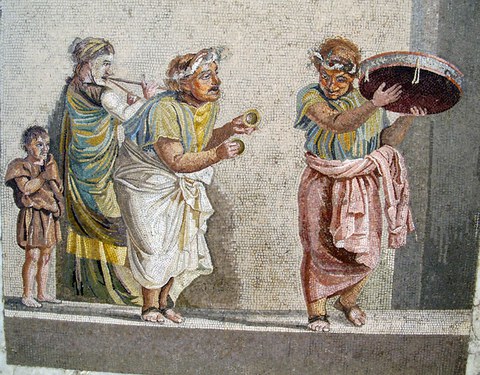Past lectures
Here you can take a look at the topics on which lectures have already been held at the Children's University.
Table of contents
Wintersemester 2025/26
How does the air connect us? Answers in 630 breaths and a castle in the air
Neli Wagner & Nele-Hendrijke Lehmann
Curators of the exhibition "Air. One for all"
September 30, 2025 | 5:30 pm | Deutsches Hygiene-Museum Dresden, Great Hall
You can only rarely see and feel it, but air connects you to the world. What you inhale now may have just been exhaled elsewhere: humans, plants and animals are in constant exchange via the air. In this lecture, we will trace some of these connections and follow the movements of the air into the past and future. Together we will build a castle in the air - we don't need any materials for this, a great imagination is all we need!
Why isn't all garbage the same?
Benjamin Schwan, M.Sc.
Research Associate at the Institute of Waste Management and Circular Economy, TU Dresden
October 21, 2025 | 5:30 pm | TU Dresden, Schönfeld lecture hall
Waste is not just waste - there are many different types! Paper, plastic, glass, organic waste or residual waste - each belongs in its own garbage can. Why? Because we can make new things out of many things: Waste paper becomes new paper, old bottles become new glasses! This is how we protect animals, plants and our environment. If we separate things properly, waste becomes treasure. But why is that? How can recycling protect our environment? What does waste have to do with climate change? And what is waste anyway?
High-tech instead of band-aids - what will the operating theater of the future look like?
Prof. Dr. StefanieSpeidel
Professor of Translational Surgical Oncology at the National Center for Tumor Diseases (NCT/UCC) Dresden
November 04, 2025 | 5:30 pm | TU Dresden, Schönfeld lecture hall
Surgery today is a truly high-tech science. In modern operating theaters, doctors are increasingly working together with robots. These robots can perform particularly precise movements - controlled by humans and supported by artificial intelligence (AI). In her lecture, Professor Stefanie Speidel will show you how surgical robots work and how AI can be used to teach them to perform certain tasks independently. You will learn how these systems can think for themselves during an operation, provide important information or even recognize risks at an early stage. Immerse yourself in the world of digital medicine - and take a look into the operating theater of the future!
Sounding plants - what music is in a cactus?
Ulrike Gärtner, director and curator
Albrecht Scharnweber, clarinettist
Both founded the PflanzenKlangLabor Dresden.
November 11, 2025 | 5:30 pm | Deutsches Hygiene-Museum Dresden, Great Hall
Can a cactus be a musical instrument? Can carrots, celery and leeks become a vegetable orchestra instead of a vegetable soup? Can electricity come from a potato and can we hear it?
Ulrike Gärtner and Albrecht Scharnweber from the Plant Sound Laboratory have researched how plants can sound. In the lecture, you can immerse yourself with them in the world of sounding plants and find out which sound is in which plant.
Summer semester 2025
From class voting to the Bundestag election - Why do we vote?
Stefanie Gerstenberger
Institute of Political Science, TU Dresden
April 1, 2025 | 5:30 p.m. | TU Dresden, Lecture Hall 03
Imagine there was a game where nobody knew what the rules were - that would be chaos! That's why we need rules that are set by elected politicians in Germany.
In 2025, it was that time again: adults were allowed to vote for the Bundestag. But why are there elections? How does it work with votes and parties? And what distinguishes democratic decisions from others?
In this lecture, we want to find out together how elections work, what constitutes democracy and what elections are all about. And best of all, you can try out for yourself how difficult it is to make decisions together.
Stefanie Gerstenberger wanted to be a logo! presenter as a child.
The enigma of Nasca - How did the whale get into the desert?
Christiane Richter
President of the association "Dr. Maria Reiche - Linien und Figuren der Nasca-Kultur in Peru" e. V. and member of the Nasca research project at the HTW Dresden
April 15, 2025 | 5:30 p.m. | Deutsches Hygiene-Museum Dresden, Great Hall
Whale, monkey, hummingbird or algae - huge images of animals and plants cover the Nazca desert in distant Peru. Gigantic spirals, kilometer-long lines, triangles and trapezoids can also be found here. But you can only really see them all from the air. But who made these drawings and, above all, how and why? Can modern science solve the mystery?
We want to get to the bottom of these and many other questions in the lecture.
Christiane Richter was fascinated by the theater as a child and wanted to study acting or singing.
From the head to the feet: Why should we actually be rational?
Prof. Dr. Moritz Schulz
Chair of Theoretical Philosophy, TU Dresden
April 29, 2025 | 5:30 p.m. | Deutsches Hygiene-Museum Dresden, Great Hall
We've probably all heard it before: "Be reasonable for once!" But why is that? What's so good about making decisions with a cool head? And does that mean we have to avoid all the things that seem unreasonable but are so much fun? The lecture asks what reason actually is, presents answers from philosophy and considers whether we can still eat jelly babies until we have a stomach ache.
Moritz Schulz wanted to work in garbage collection as a child.
Species conservation up close - How can we save the field hamster?
Thomas Liebenstein
Project manager for species conservation at Leipzig Zoo
May 13, 2025 | 5:30 p.m. | TU Dresden, Lecture Hall 03
Did you know that the European hamster is threatened with extinction in Saxony and throughout Germany? But don't worry, there's an exciting project to help it! Thomas Liebenstein, species conservation expert at Leipzig Zoo, introduces the project. He explains how the zoo is using breeding programs and reintroductions to ensure that the hamsters can return to the wild. In the lecture, you will find out why the European hamster is in danger and what we can do to help it. Join us and learn how each of us can protect nature!
Thomas Liebenstein wanted to be a vet as a child.
Winter semester 2024/25
How big is infinity? Infinity in mathematics and elsewhere
Prof. Dr. Andrea Hoffkamp
Chair of Didactics of Mathematics, TU Dresden
October 22, 2024 | 5:30 p.m. | Deutsches Hygiene-Museum Dresden, Great Hall
What actually is infinity? We might imagine something huge or eternal - bigger than everything! But is there anything in the world that is infinite? Can we be completely sure? In mathematics, we have learned throughout history how to deal with the infinite and have even invented our own symbol: a horizontal eight ∞. In the lecture, you will learn where the infinite appears everywhere and why we need it to describe the world. In the process, we come across reasonable and unreasonable numbers, strange infinite sums, infinity in geometry and architecture and much more.
Andrea Hoffkamp wanted to be a vet as a child.
Participation, co-determination and self-determination - What are my children's rights in the (digital) world?
JProf Dr. Katharina Kaesling
Juniorprofessorship in Civil Law, Intellectual Property, in particular Patent Law, and Legal Issues of AI, TU Dresden
November 05, 2024 | 5:30 p.m. | TU Dresden, Lecture Hall 03
The United Nations Convention on the Rights of the Child clearly states: Your perspective is important! Every child has rights that are intended to ensure the protection, promotion and participation of children - including on the internet, in gaming apps and in class chats. These rights include freedom of expression and information, the right to participate and play, privacy and data protection, education and media literacy. Together, we want to look at what these rights mean for you and where they have their limits. For example, who needs to be asked whether a photo of you can be shared on social media? Have you ever bought or clicked on something and then realized that you didn't actually want to? How can the law help in dealing with the tricks used by providers ("dark patterns")?
Katharina Kaesling wanted to be a language teacher as a child.
Mysterious hidden world: How the invisible microcosm determines our lives
Prof. Dr. Thorsten Mascher
Chair of General Microbiology, TU Dresden
November 19, 2024 | 5:30 p.m. | TU Dresden, Lecture Hall 03
Microbes are everywhere in us, on us and around us - and yet we cannot see them. But we can smell and taste that they are there! They have ensured that the earth is habitable in the first place and still provide us with the air we breathe today. They remove our waste and provide us with wonderful food. And although some microbes can make us ill, most of them are responsible for our health. Because without them, our own bodies would not function. Who are these invisible all-rounders that are so important and yet live in secret? This lecture provides information about them.
Thorsten Mascher wanted to be a pilot as a child.
What is air? A journey of discovery with experiments
Prof. Dr. Stefan Kaskel
Chair of Inorganic Chemistry, TU Dresden
December 10, 2024 | 5:30 p.m. | Deutsches Hygiene-Museum Dresden, Great Hall
Is air an element? What is it actually made of? Is there good and bad air? You are surrounded by it from birth. But have you ever thought about what you breathe in and out every day? we go on a journey of discovery and play games to understand how air is made up. Through experiments, we show how the different components of air can be made visible and which components are important for people and the environment. If you join in and think, you can rediscover the world!
Stefan Kaskel also wanted to become a pilot.
Summer semester 2024
Knowledge with a bite - emergency call from the oral cavity
Dr. med. dent. Ursula Schütte, dentist and head of the Children's and Youth Dental Clinic of the state capital Dresden
Prof. Dr. med. dent. Christian Hannig, dentist and Director of the Polyclinic for Dental Conservation at the University Hospital Dresden
Dr. med. dent. Nora Johannes, dentist in the Department of Pediatric Dentistry at the Polyclinic for Tooth Preservation at Dresden University Hospital
April 9, 2024 | 5:30 p.m. | TU Dresden, Lecture Hall 03
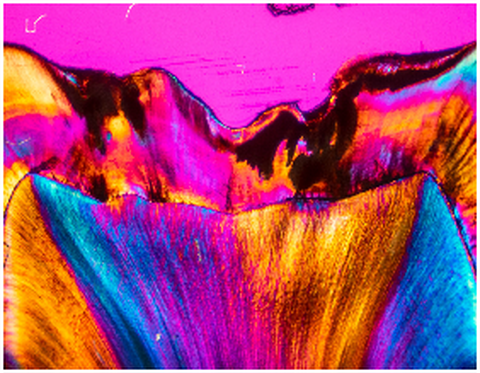
Auf dem Bild sieht man ein mikroskopisches Präparat (einen Dünnschliff), welches einen Backenzahn im Querschnitt zeigt. Die Zahnhartsubstanzen Schmelz und Dentin sind zu erkennen. Man sieht das erste Stadium einer Karies, also eine Demineralisation im Schmelz, welche im farbigen Bild in der Region des Schmelzes schwarz erscheint.
We embark on a journey into the mouth and to the surface of the teeth. Can sharks or monkeys get tooth decay? And what happens on the tooth surface after brushing? When is a filling necessary and how does the filling stick to the tooth?
What do teenagers need to pay attention to when brushing their teeth? And what should I do if I injure my teeth in an accident?
We can answer all these questions - from a dental and scientific perspective.
Dr. UrsulaSchütte and Dr. Nora Johannes wanted to be teachers when they were children. Prof. Christian Hannig wanted to become a biochemist or aerospace engineer.
Of little and big vampires: Why do we love monsters in the movies but not under our own bed?
Dr. Frank Schmidt
Art historian at the Chair of History of Art at TU Dresden
April 23, 2024 | 5:30 p.m. | Deutsches Hygiene-Museum Dresden, Great Hall
From Count Zahl to the little vampire: there are no bloodsuckers, and yet they are everywhere. In addition to books and video games, they prefer to make themselves comfortable in dark movie theaters. No fantasy creature has been the subject of more films than Dracula. But why are vampires so successful and where do they come from? What are vampire books actually about? And what does their invention have to do with a volcanic eruption, bad weather and Frankenstein? In this lecture, we will follow the trail of nightwalkers and other eerie creatures. We also want to find out why we sometimes like to be creeped out and still don't have to be afraid.
Dr. Frank Schmidt wanted to be a comic artist as a child.
Of puzzles and bananas - How do we explore what monkeys think?
Dr. Elisa Felsche
Comparative psychologist at the Max Planck Institute for Evolutionary Anthropology in Leipzig
April 30, 2024 | 5:30 pm | Deutsches Hygiene-Museum Dresden, Great Hall
Many animals can swim, run or climb better than we can. But when it comes to thinking, humans seem to have something over others. Our closest relatives, the great apes, also organize their lives in groups, find their way around the rainforest and use tools. But how smart are apes really and do they think like us? This lecture is about how we use tricky tasks and close observation to find out whether apes can also calculate, remember things, plan or solve problems together.
Dr. Elisa Felsche didn't know what she wanted to be when she was little.
Why do markets organize our economy?
Prof. Dr. Christian Leßmann
Chair of Economics, esp. International Economics at the TU Dresden
June 4, 2024 | 5:30 p.m. | TU Dresden, Lecture Hall 03
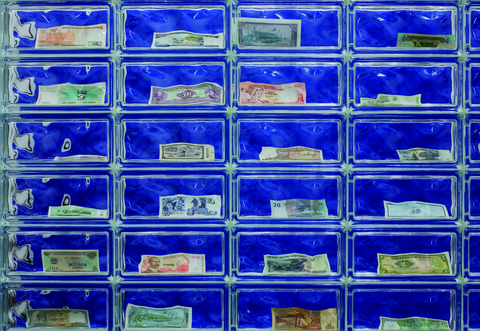
Bild aus der Reichtumsausstellung im Deutschen Hygiene-Museum Dresden
Everyone has bought something at some point: whether sweets, books or toys. You go into a store and see the price of a product. Then you buy it if it is worth at least as much to you personally as the price you have to pay. Of course, you also have to have enough pocket money. Although we all like sweets or books in different ways, there is one price for everyone in the store. How do these prices come about? What are the consequences for all of us? We will find out these and other questions in a playful hands-on experiment.
Prof. Christian Leßmann comes from a family of construction companies and wanted to be a crane operator for mobile cranes as a child.
Winter semester 2023/24
Why did artists in the Middle Ages paint cats and mice on the wall?
Prof. Dr. Markus Santner
Professor of Art Technology, Conservation and Restoration of Wall Painting and Architectural Surfaces (Dresden University of Fine Arts)
October 17, 2023 | 5:30 pm | Deutsches Hygiene-Museum, Great Hall
Many people in the Middle Ages could neither read nor write. So that people could still be informed, the stories were simply painted on the wall. To do this, artists needed various materials such as lime, sand, brushes, paints and technical aids. Prof. Markus Santner explained in the lecture what artistic techniques were used back then and what needs to be done today to preserve and protect these old works of art for as long as possible.
Prof. Santner wanted to be a painter as a child.
Scaredy-cat my ass - you can learn to be brave
Prof. Dr. Susanne Knappe
Graduate psychologist and psychotherapist for children, adolescents and adults, Professor of Health Sciences (Evangelische Hochschule Dresden)
October 24, 2023 | 5:30 p.m. | TU Dresden, Lecture Hall 03
"Anxiety" - is that a feeling in your stomach? When the thoughts in your head go crazy? Can you see fear? Fear helps us to survive, it protects us from danger. It can also get out of control when we are so afraid of things, people or animals that our everyday life is thrown into disarray. To a children's party in the yard - "Oh no, nobody likes me there anyway", to a trip to the country with the 3d - "But I'm afraid of the dark", playing with your best friend - "Yes, but only if her dog isn't there". In her lecture, Prof. Knappe explained what constitutes fear, how to get rid of too much fear and how to learn to become courageous.
As a child, Prof. Knappe didn't know what she wanted to be when she grew up.
Talking to beetles?
Prof. Dr. Michael Müller
Chair of Forest Protection (TU Dresden)
November 7, 2023 | 5:30 pm | TU Dresden, Lecture Hall 03
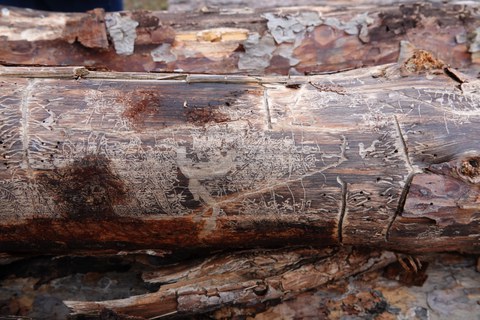
Hier zu sehen sind die Muster, die Borkenkäfer auf einer Kiefer hinterlassen haben.
Plants and insects communicate with each other. This can be done e.g. via colors, taste, smell but also via sounds. Communication is used, for example, to find food, partners and breeding sites, but also to deter and ward off attacks. If we research this communication, we can interfere in "the conversations" and use this for our own benefit. The young students were able to overhear some of these "conversations" with Prof. Müller.
Prof. Müller wanted to be a forest engineer as a child.
Discovering the past with a shovel and wheelbarrow? On the road with the horse-riding nomads of the Iron Age!
Dr. Karina Iwe
Archaeologist and exhibition manager at the Book Museum of the SLUB Dresden (Saxon State and University Library Dresden)
November 21, 2023 | 5:30 pm | Deutsches Hygiene-Museum Dresden, Great Hall
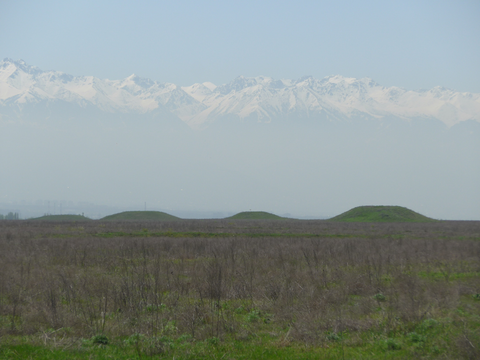
Grabhügel bei Almaty, Kasachstan
Together we immerse ourselves in a time over 2200 years ago. What do the mounds in the steppe landscape tell us about? Why do archaeologists discover horses in graves? What stories do mummies tell? Dr. Karina Iwe took the children to the equestrian nomads of the Iron Age: together they looked at the archaeological traces in a wild ride and explored the exciting topic of archaeology.
Dr. Iwe wanted to be a vet until the age of 8, but then she wanted to become an archaeologist.
Summer semester 2023
The superpowers of axolotls and zebrafish: what can we learn from their self-healing mechanisms?
Dr. Judith Konantz
Molecular biologist at the Center for Regenerative Therapies Dresden
April 4, 2023 | 5:30 pm | TU Dresden, Lecture Hall 03
The human body is an impressive organism. We can see, smell, hear, walk, think and taste. We can even heal minor and medium wounds ourselves. For example, if we hit our knee. But for large wounds, we need medical help. Doctors can often work small miracles, but a lost finger can only be saved if it is reattached in time. It is even more difficult with a whole arm. Our self-healing mechanisms are not sufficient to allow a whole finger or arm to grow back on its own. Biologist Dr. Judith Konantz explains what this has to do with axolotls and zebrafish.
Dr. Konantz wanted to be a painter or architect as a child.
First pour, then enjoy: How does the filling get into the chocolate?
Dr.-Ing. Birgit Böhme
Research Associate in the Food Technology team at the Institute of Natural Materials Technology (TU Dresden)
April 25, 2023 | 5:30 p.m. | Deutsches Hygiene-Museum, Great Hall
9 out of 10 people like chocolate, the 10th is lying. In any case: chocolate tastes good! Preferably with lots of filling and preferably with nougat or milk. But how does the cream filling get into the chocolate? How much filling fits in and how can you recognize how the sweet balls, cubes or bars are made? In the lecture, Dr. Birgit Böhme explained how particularly beautiful chocolates are made and much more.
As a child, Dr. Böhme wanted to work as an artist in the circus or become a jockey.
Ancient languages, distant sounds: what did the ancient world sound like?
Junior Professor Dr. Mario Baumann
Holder of the Junior Professorship "Cultures of Antiquity/Greek Literature" (TU Dresden)
May 16, 2023 | 5:30 p.m. | Deutsches Hygiene-Museum, Great Hall
Antiquity fascinates us with its buildings as much as with the myths and texts that have been passed down to us. We often wish we could travel back in time and experience the ancient world first-hand. In his lecture, Prof. Jun. explained how we can at least come close to such a journey through time: by pricking up our ears and allowing ourselves to be inspired by the sound of ancient music and languages. In addition to many examples with often quite unexpected sound impressions, the lecture also dealt with how we actually know all this and what we learn about the ancient world in this way.
As a child, Prof. Baumann wanted to be an Egyptologist.
Fireflies or balls of gas - what are stars?
Dominik Koll
Doctoral student at the Australian National University and TU Dresden and pyhsicist at the Helmholtz-Zentrum Dresden-Rossendorf
June 13, 2023 | 17:30 | TU Dresden, Lecture Hall 03
We see them in the sky every night - countless stars. But where do stars come from? Why do they shine? And are stars fireflies or balls of gas? Join Timon and Pumbaa from The Lion King on their journey to a star and find out why we are all made of stardust. Learn how the building blocks of life are created in the vastness of the universe. Dominik Koll is a physicist and researches stars and their significance for the creation of chemical elements, the structure of the universe and life on earth.
As a child, Mr. Koll wanted to become a snake researcher like "The Crocodile Hunter" Steve Irwin.
Lectures 2022 - 2004
Winter semester 2022/23
November 1, 2022| 5:30 pm | Zoom
Why think if you don't have to? About the joy of thinking
Prof. Dr. Alexander Strobel, Chair of Differential and Personality Psychology (TU Dresden)
Die Kinder-Uni-Vorlesung „Warum denken, wenn man nicht muss?“ © Kinder-Universität Dresden
Thinking can be exhausting, and people usually avoid exertion. But some people really enjoy thinking. They even think about things when they don't have to. They observe the world and think about it to find out why things are the way they are. And when this becomes exhausting, they enjoy it even more. In the lecture, Prof. Alexander Strobel reported on what distinguishes these people. With the help of scientific findings, he showed that these people are often not only more successful and happier at school, but also less anxious and less often sad.
November 15, 2022 | 5:30 pm | Zoom
Do electron penguins waddle through our cell phones and dance ballet?
Dr. Tobias Meng, Head of the Quantum Design working group at the Institute of Theoretical Physics (TU Dresden)
Die Kinder-Uni-Vorlesung „Watscheln Elektronen-Pinguine durch unsere Handys und tanzen Ballett?“ © Kinder-Universität Dresden
Even the smallest particles like to do things together! Physicist Tobias Meng explained in his lecture that they waddle through the cell phone like electron penguins, cuddle at the South Pole or dance a ballet. In a group, electrons can do things that don't work on their own - for example, conducting electricity without losing energy. This is called superconductivity and is currently only possible at temperatures colder than the Siberian winter. To make this work at room temperature, Dr. Meng is researching the secret life of electrons. He wants to make it usable for our everyday lives. In this way, he is also helping to make the quantum computer a reality one day.
November 29, 2022| 5:30 pm | Zoom
Cities of the future - what did they look like yesterday and what will they look like tomorrow?
Prof. Dipl.-Ing. Architect Melanie Humann, Chair of Urbanism and Design (TU Dresden)
Die Kinder-Uni-Vorlesung „Wie sehen Städte der Zukunft aus?“ © Kinder-Universität Dresden
What will cities look like in the future? How do we want to live together? And how do we plan cities in the first place? These questions have not just been on our minds since today. Even in the past, people thought about how cities could be different and better. They invented large objects that wandered through the desert or huge towers that could hold an entire city. But what shaped the ideas of that time and how do we actually imagine a future city today? In the lecture, architect Melanie Humann gave an insight into past and present urban fantasies.
December 6, 2022| 5:30 pm | Zoom
Gigantic and ancient: what are dinosaurs and where and how do you find them?
Dr. Oliver Wings, Director of the Bamberg Natural History Museum
Die Kinder-Uni-Vorlesung „Was sind Dinosaurier und wo findet man sie?“ © Kinder-Universität Dresden
Every child knows dinosaurs. But did you know that dinosaur fossils can also be found in quite a few places in Germany? In the lecture, you will not only find out why this is the case, but also whether there is a difference between dinosaurs and dinosaurs. Dr. Oliver Wings also talked about his own experiences during excavations and what you have to bear in mind when you find ancient dinosaur bones.
Summer semester 2022
April 5, 2022| 5:30 pm | Zoom
How do plants and animals help engineers solve technical problems?
Prof. Dr. Christoph Neinhuis, Chair of Botany and Director of the Botanical Garden at TU Dresden
Die Kinder-Uni-Vorlesung „Wie helfen Pflanzen und Tiere Ingenieur:innen bei der Lösung von technischen Problemen?“ © Kinder-Universität Dresden
Over the course of many millions of years, nature has found sometimes astonishing, often very effective solutions to numerous problems that also occur in technology. This applies to very different areas: In animals, for example, this ranges from flying and swimming to walking on water, in plants from efficient growth and transportation of material to great heights, clever packaging to keeping surfaces clean. Prof. Neinhuis used a number of examples in his lecture to explain the solutions that nature has found and how these are used in technology.
April 12, 2022 | 5:30 p.m. | Zoom
Why home, actually?
Dr. Johannes Schütz, Research Associate at the Chair of Modern and Contemporary History (TU Dresden)
Die Kinder-Uni-Vorlesung „Wieso eigentlich Heimat?“ © Kinder-Universität Dresden
Heimat ("home") is everywhere right now: politicians are talking about it, writers are writing about it and museums are exhibiting it. But why are so many people looking for a very concrete idea and description of home right now? What ideas of home are there and how do they differ? And how can a look at history help us to understand it better? These are questions to which the historian Dr. Johannes Schütz will provide answers in his lecture.
May 3, 2022| 5:30 pm | Zoom
Phrases on the pitch: Is there a soccer language?
Prof. Dr. Simon Meier-Vieracker, Chair of Applied Linguistics (TU Dresden)
Die Kinder-Uni-Vorlesung „Phrasen auf’m Rasen: Gibt es eine Fußballsprache?“ © Kinder-Universität Dresden
"The round must go into the square", "After the game is before the game" - when we think of soccer, we not only have stadium noises in our ears, but also the many phrases that are trotted out when talking about soccer. But is soccer language really so phrase-like? And what other characteristics does it have, and is it even possible to speak of a specific soccer language? In his lecture, linguist Prof. Dr. Simon Meier-Vieracker took you on a journey through the language of soccer and showed you, among other things, how computers can help with language analysis.
May 17, 2022| 5:30 pm | Zoom
Dr. Robot to the operating room, please - What will the operating room of the future look like?
Prof. Dr. Stefanie Speidel, Professor of Translational Surgical Oncology at the National Center for Tumor Diseases Dresden
Die Kinder-Uni-Vorlesung „Dr. Roboter bitte in den OP – Wie sieht der Operationssaal der Zukunft aus?“ © Kinder-Universität Dresden
Surgery as a high-tech discipline has developed rapidly in recent decades. New technological innovations such as robots are finding their way into the operating theater and helping to improve surgery. In her lecture, Professor Stefanie Speidel provided insights into the topic of robot-assisted surgery. You learned how surgical skills can be transferred to a robot using artificial intelligence and how intelligent computer systems can support surgeons at the right time during an operation.
Winter semester 2021/22
October 5, 2021| 5:30 pm | Zoom
Collecting sounds in Ecuador: What can we understand when we listen to nature?
Junior Professor Dr. Miriam Akkermann, Junior Professor for Empirical Musicology (TU Dresden)
Die Kinder-Uni-Vorlesung „Klänge sammeln in Ecuador: Was können wir verstehen, wenn wir die Natur belauschen?“ © Kinder-Universität Dresden
Many things around us make sounds that we know well, like the bird outside the window or children in the garden. But we also hear very quiet sounds, the rustling of leaves in the forest, the buzzing of insects in the meadow. All these sounds tell us loud or quiet stories. Sometimes they are very easy to understand. But sometimes you have to record the sounds and listen to them several times to understand everything. Junior Professor Dr. Miriam Akkermann listened to nature in Ecuador and collected sounds on a glacier and in the cloud forest. What do they tell us? And why is this also helpful in understanding how much influence humans have on the earth?
November 2, 2021 | 5:30 pm | Zoom
Why are there disasters in nature?
Prof. Dr. Arno Kleber, Professor of Physical Geography (TU Dresden)
Die Kinder-Uni-Vorlesung „Warum gibt es Katastrophen in der Natur?“ © Kinder-Universität Dresden
Natural disasters can happen quickly, such as earthquakes, volcanic eruptions or storms. Prof. Kleber explained how and why they occur in his lecture. The examples he gave mainly occurred in the USA, Prof. Kleber's main field of research. However, his lecture also dealt with gradual natural disasters such as environmental pollution and climate change.
November 16, 2021| 5:30 pm | Zoom
Did 'dissing', 'hating' and 'bullying' exist before the internet?
Private lecturer Dr. Silke Fehlemann, Research Associate at the Chair of Modern and Contemporary History (TU Dresden)
Die Kinder-Uni-Vorlesung „Gab es ‚Dissen‘, ‚Haten‘ und ‚Mobben‘ schon vor dem Internet?“ © Kinder-Universität Dresden
Insults play a major role in social media. But what was it like before the internet? How can historians research the history of insults? Using examples from the 20th century, we looked together at the media through which insults were spread in the past and what effects they had on those affected. Which insults were particularly effective and why? What goals could insulters pursue and how did disparagement affect those affected? Dr. Fehlemann answered these questions using various examples from the period of the Weimar Republic (1919-1933).
November 23, 2021| 5:30 pm | Zoom
Full board in a space hotel: what do humans need to survive in space?
Dr. Tino Schmiel, Head of the Satellites and Space Sciences research field, Institute of Aerospace Engineering (TU Dresden)
Astronauts cannot do without oxygen, water and food; however, deliveries into space are only possible to a limited extent. Dr. Tino Schmiel from the Institute of Aerospace Engineering at TU Dresden explained how astronauts can still be supplied with everything they need on the space station during his children's university lecture.
Summer semester 2021
April 13, 2021 | 5:30 p.m. | Zoom
How do you use spit and glue to catch thieves?
Dr. Maria Winzi, Biology/DNA analysis expert at the Saxony State Office of Criminal Investigation
Jörg Pfeifer, Forensic science lecturer at the Saxony Police University
Die Kinder-Uni-Vorlesung „Wie kommt man mit Spucke und Kleber Dieben auf die Schliche?“ © Kinder-Universität Dresden
Finding thieves is not that easy. When something is stolen, all that is often left behind is empty packaging, empty bottles or broken doors. Then you often don't know who to look for. There are two methods in forensic science that can do just that - identify people by the traces they leave behind. These are dactyloscopy and forensic DNA analysis. Dactyloscopy sounds very cumbersome and comes from two words in the Greek language "daktylos - finger" and "skopein - to look". This forensic field of work looks at the thieves' fingers and you can find out how it works here! Thanks to technical developments, the traces examined have become smaller and smaller, right down to the basic building blocks of human DNA. For example, forensic DNA analysis can determine the culprit from a little spit on a drunk bottle. But we won't find out about the glue until the lecture!
April 27, 2021 | 5:30 pm | Zoom
What is climate change doing in the cooking pot?
Dr. Benjamin Leon Bodirsky, Economist and climate researcher, Potsdam Institute for Climate Impact Research
Die Kinder-Uni-Vorlesung „Was macht der Klimawandel im Kochtopf?“ © Kinder-Universität Dresden
Our planet is getting warmer - but what does that have to do with what we eat? In this lecture, you will learn how burping cows, drained peatlands and deforested forests are causing the planet to get warmer, what farmers can do to adapt to a warmer climate and what we can all do to prevent the earth from getting too warm.
May 18, 2021 | 5:30 pm | Zoom
Plastic on a diet - the planet will be happy
Dr. Robert Kupfer, Engineer at the Institute of Lightweight Engineering and Polymer Technology at TU Dresden
Die Kinder-Uni-Vorlesung „Plastik auf Diät – da freut sich der Planet“ © Kinder-Universität Dresden
No material has such a bad reputation and is at the same time as important as plastic. Bet each of you has at least three plastic things in your environment - clothes, toys, technology? We know that plastic can be bad for the environment. And yet it's hard to do without it. Let's explore how we can get out of this dilemma. To do this, we need to find out why plastic is so great on the one hand and causes such problems on the other. Then we'll see if we can use it and still protect the environment. Finally, you'll find out why we'll still need clever people and clever ideas in the future.
June 1, 2021 | 5:30 pm | Zoom
How does the water get into the tap?
Dr. Dirk Freitag-Stechl, Chemist, Managing Director of CUP Laboratorien Dr. Freitag GmbH
Die Kinder-Uni-Vorlesung „Wie kommt das Wasser in den Wasserhahn?“ © Kinder-Universität Dresden
Drinking water is by far the most important food for us. We consume it in large quantities every day by drinking it, bathing in it, cooking with it or flushing our toilets. The great thing about drinking water in Germany is that it simply flows out of the tap in seemingly unlimited quantities. But what happens to the water until it reaches the tap and where does it go afterwards? These questions and many others about drinking water are asked and answered in the lecture.
Winter semester 2020/21
November 17, 2020 | 5:30 pm | Zoom
How can you read minds using computer science?
Prof. Dr. Nadine Bergner, Chair of Didactics of Computer Science at the Faculty of Computer Science at TU Dresden
Die Kinder-Uni-Vorlesung „Wie kann man mittels Informatik Gedanken lesen?“ © Kinder-Universität Dresden
Prof. Bergner can count to 1000 with her fingers. She can read your mind. And she can explain what all this has to do with computer science. Can you? If not, then the "Magic School of Computer Science" is the right place for you! In this lecture, you will learn how to speak like a computer, because it only knows two characters, namely 0 and 1. Prof. Bergner also wants to read your mind. You don't believe she can do that? Then join us and see for yourself. You don't have to worry, she won't cast a spell on you. Only your parents should be worried, as you will also be able to read minds after this lecture.
Summer semester 2020
There were no lectures this semester due to the corona-related lockdown.
Winter semester 2019/20
October 8, 2019 | 5:30 pm | Deutsches Hygiene-Museum, Great Hall
How does a butterfly live?
Dr. Matthias Nuss, Head of the Lepidoptera Section, Senckenberg Museum für Tierkunde Dresden
What would a summer meadow be without the silent and colorful butterflies that fly on it? And where are they in winter? Butterflies are quick-change artists. They look completely different as children than when they are fully grown. But they always feed on plants. In this lecture, the children learned from an entomologist what they think of them and how to care for a meadow so that butterflies can live on it.
October 29, 2019 | 5:30 p.m. | Deutsches Hygiene-Museum, Great Hall
What do the trees tell us?
Dr. Solvejg Nitzke, Literary scholar at the Institute of German Studies, TUD Dresden University of Technology
Trees are more active than we think. They produce oxygen and fruit, provide shade and are not only quite talkative among themselves. There are trees that lash out if you annoy them. Some also help to defeat big villains. Some were once people and quite a few have a lot to tell. This is not only the case in fairy tales or fantasy novels... The joint journey took us into the world of trees and together we looked at how similar real and invented trees are. How do we make the trees speak? What stories do they have to tell? How and where can we hear or read these stories? And can we perhaps even tell stories like a tree ourselves?
November 12, 2019 | 5:30 pm | TUD Dresden University of Technology, Lecture Hall 3 in the Auditorium Center
Where do all these heroes come from?
PD Dr. Wieland Schwanebeck, Literary scholar at the Institute of English and American Studies, TUD Dresden University of Technology
For as long as people have been telling stories, heroes have played a major role in them - and these stories are similar in many ways, whether they come from ancient Greece, the Middle Ages or our own time, such as the Harry Potter books. Using many examples from old and new stories, films and games, the children were able to find out what is involved in a typical "hero's journey", what tools heroes always have with them and why people need adventurous heroic stories. Together they considered why these stories will probably still find an enthusiastic audience in 1000 years' time.
November 26, 2019 | 17:30 | TUD Dresden University of Technology, Lecture Hall 3 in the Auditorium Center
What can DNA tell us about the abilities of living beings?
Dr. Michael Hiller, TUD Young Investigator, Bioinformatician at the Max Planck Institute of Molecular Cell Biology and Genetics
What determines the appearance and abilities of a living being? To a large extent the genetic material, i.e. the DNA. DNA is a long sequence of letters. In contrast to the German language, which uses 26 different letters, DNA only consists of four letters, namely A, C, G and T. In the lecture, the children learned what we can deduce about the characteristics of living beings from these four letters in DNA. In particular, they compared the DNA of humans, guinea pigs, bats and sperm whales as well as genes and vitamins.
Summer semester 2019
April 2, 2019 | 5:30 p.m. | TUD Dresden University of Technology, Lecture Hall 3 in the Auditorium Center
How does a living being form?
Prof. Dr. Stephan Grill, Biophysicist at the Biotechnology Center of the TUD Dresden University of Technology
Every living being consists of millions of cells. How do all these cells know where to go and what to do? How can organs form from cells; how can a hand form, for example? In his lecture, Prof. Grill explained how cells connect and how they themselves apply forces to organize themselves and to bring cell structures and tissue into the right shape. Using the example of a fly, a fish and a worm, he illustrated the similarity between growing living creatures and a piece of plasticine and explained how, unlike plasticine, living creatures can form themselves completely independently.
April 9, 2019 | 5:30 p.m. | Deutsches Hygiene-Museum, Great Hall
I love to cuddle you! Why cuddling feels so good
Junior Professor Dr. Ilona Croy, Psychological psychotherapist, Clinic and Polyclinic for Psychotherapy and Psychosomatics, Carl Gustav Carus University Hospital at the TUD Dresden University of Technology
You probably know how nice it is to scurry into bed early with your parents and give them a big cuddle. A hug like that feels really good. Especially when we are sad, we seek comfort in the arms of our family and friends. But why is that actually the case? One reason is that our heartbeat slows down when we are touched and cuddled. This means that we relax. In the lecture, the children learned what else touch is good for, how touch enters our brain and what happens to our body when we are touched.
April 30, 2019 | 5:30 p.m. | Deutsches Hygiene-Museum, Great Hall
What's going on on the sun?
Prof. Dr. Manfred Schüssler, Solar physicist at the Max Planck Institute for Solar System Research, Göttingen
Without the sun, there would be no life on Earth, because it provides us with light and warmth. But the sun is much more than just a heat lamp: it is constantly bubbling on its surface, strange dark spots appear and disappear again, and again and again it spews out huge hot gas clouds. This raises many questions: What is the sun actually? Has the sun always existed or where does it come from? Why is the sun so restless? With Prof. Schüssler, the children took a close look at the sun and also addressed the burning question: Does the sun have hair?
May 14, 2019 | 5:30 pm | TUD Dresden University of Technology, Lecture Hall 3 in the Auditorium Center
How do you investigate something you can't see? A lecture on electric current
Dr. Jens Müller, Engineer at the Chair of Fundamentals of Electrical Engineering, TUD Dresden University of Technology
People have been investigating electrical phenomena for over 2,500 years. Today, we use it in devices without which we can no longer imagine life - cell phones, lamps, streetcars, televisions and many more. But what actually is "electricity"? Where does it come from and how can it be detected even though we can't see it? To answer these questions, Dr. Müller explored the origins, effects and applications of electricity with the children in the lecture using interesting experiments.
Winter semester 2018/19
October 2, 2018 |17:30 | Deutsches Hygiene-Museum, Great Hall
Why is Dresden called the Florence on the Elbe?
Prof. Dr. Maria Lieber, Professor of Romance Studies and Director of the Italy Center at TU Dresden
PD Dr. Christoph Oliver Mayer, Privatdozent (PD) for French and Italian Cultural and Literary Studies at TU Dresden
When tourists rave about Dresden, they often refer to the city as the Florence on the Elbe. But where does this nickname come from and what do Dresden in Saxony and the Italian city of Florence in Tuscany really have in common? On the occasion of the 40th anniversary of the city partnership between Florence and Dresden, the historical roots were illuminated, explained what a city partnership is and where we can find Florentine traces in Dresden. Perhaps one or two of the visitors were inspired to spend their next vacation in Florence or to read Dante.
October 23, 2018 |17:30 | TUD Dresden University of Technology, Lecture Hall 3 in the Auditorium Center
How do all these things get into the museum?
Nanette Jacomijn Snoep, Ethnologist and Director of the three museums of ethnology in Saxony - Grassi Museum für Völkerkunde zu Leipzig, Museum für Völkerkunde Dresden and Völkerkundemuseum Herrnhut
Thousands of exciting objects from many different regions of the world are kept in our ethnological museums today. Dresden, Leipzig and Herrnhut also have large collections of such objects. But how did all these amazing things from Africa, Oceania, Australia, Asia, America and Europe get there? Every single piece has its own past and tells an incredible number of different stories. In the lecture, the children and the speaker explored these backgrounds and found out whether these things really belong in our museums.
November 6 | 5:30 p.m. | Deutsches Hygiene-Museum, Great Hall
Will people be able to buy superpowers in the future?
Prof. Dr. Bertolt Meyer, Professor of Organizational and Business Psychology at Chemnitz University of Technology
There are many spare parts for the human body: Artificial hands, legs, even eyes and ears. These spare parts are not yet as good as the original: you can't play the piano with an artificial hand. But this may well change in the future. Even today, a long jumper with an artificial leg can jump further than an athlete with two flesh-and-blood legs. Perhaps in the future there will be many more replacement parts that are better than the original. We therefore need to ask ourselves today whether we want such a future. Who will be able to afford it and what will it do to people?
November 20, 2018 | 5:30 p.m. | TUD Dresden University of Technology, Lecture Hall 3 in the Auditorium Center
Sign language: is it all just pantomime?
Norbert Richter, Specialist consultant in the context of hearing impairment, Dresden
Sabine Flohr, Sign language teacher, state-certified lecturer for sign language, Dresden
Andreas Mischke, Certified sign language interpreter, banker, Dresden
Sindy Christoph, Certified sign language interpreter, vocational teacher, Dresden
You've probably seen people in movies who are silently but gesticulately facing each other. Did you notice that they never took their eyes off each other? Were they perhaps agents exchanging secret signs? No - they must have been deaf people talking to each other with their hands. They "hear" with their eyes. In this lecture, the children got to know German sign language. They were then able to communicate silently using simple signs and communicate with their friends using secret signs - an exciting insight into the world of deaf people.
Summer semester 2018
March 27, 2018 | 5:30 pm | TUD , Lecture Hall 3 in the Auditorium Center
The visible and the invisible - How are colors created from light?
Prof. Dr. Gesche Pospiech, Chair of Didactics of Physics at the TUD Dresden University of Technology
Everything around us is colorful. We see bright colors in nature, such as the rainbow, and colored objects in our environment. How do these colors come about with the help of white light? How can we mix colors ourselves and thus create new colors? In the lecture, the children were able to get to the bottom of light and study exactly which methods can be used to create and change colors. But there are also tricks that can be used to make much more than normal colors visible: Light can even help you look behind things and learn more about them....
April 24, 2018 | 5:30 pm | TUD , Lecture Hall 3 in the Auditorium Center
Bugs - yikes?
Prof. Dr. Klaus Reinhardt, Chair of Applied Zoology at the TUD Dresden University of Technology
Bedbugs have a bad reputation among adults, but this is mainly due to one type of bug - the bedbug. They can bite us humans and suck our blood, and afterwards it itches. And all of this in bed, of all places, where we prefer to be alone (at most a cuddly teddy bear may be present)! But that doesn't mean bugs are disgusting! Together with Prof. Reinhardt, the children were able to put themselves in the shoes of a bedbug and learn how difficult and exhausting it is to suck blood. They heard about bugs that carry their children on their backs and even met some that can walk on water without sinking.
May 15, 2018 | 5:30 p.m. | Deutsches Hygiene-Museum, Great Hall
Why is smelling important?
Prof. Dr. med. Thomas Hummel, Head of the "Smell and Taste" department at the Department of Otorhinolaryngology, Carl Gustav Carus University Hospital
We react to the body odors of our fellow human beings - our nose determines who we can "smell" or not. Even when we eat, scents and aromas determine whether something tastes good or not. Smell also influences our working lives: perfumers, bakers and chefs, for example, are absolutely dependent on their sense of smell! The sense of smell is also important for detecting fire and smoke or spoiled food. Without smell, life is much poorer!
May 29, 2018 | 5:30 p.m. | Deutsches Hygiene-Museum, Great Hall
Wolf - Who are you?
Sophia Liehn, Ecologist, "Wolves in Saxony" contact office, Rietschen
Man's best friend is the dog. But why are so many people so afraid of wolves when they are the ancestors of our dogs? How can you tell the difference between a wolf and a dog? And what is life like in a wolf family? How many wolves live in Saxony? And how do we recognize their tracks? In this lecture, the life of wolves was presented with many pictures and illustrative material and it was also explained how close our dog is to its wild ancestor.
Winter semester 2017/18
September 26, 2017 | 5:30 pm | Deutsches Hygiene-Museum, Great Hall
How did the first farmers in Saxony live?
Dr. Sabine Wolfram, Director of the smac - State Museum of Archaeology Chemnitz
Farmers have lived in Saxony for a long time. But how long exactly and what did their way of life look like back then? In this lecture, the children were able to find out when the first farmers settled in Saxony, how they built their houses, what plants they grew and what animals they kept. They were also able to see how archaeologists recognize where people, animals and plants come from and what stories of the past can be told by objects found in the smac, the State Museum of Archaeology Chemnitz.
October 24, 2017 | 5:30 pm | Deutsches Hygiene-Museum, Great Hall
Why do Bello and Minka have to go to the vet clinic? And where do they actually sleep?
Dr. med. vet. Katja Pfeil, Senior Physician at the Dresdner Heide Veterinary Clinic
Christin Schulz, assistant doctor at the Dresdner Heide Veterinary Clinic
A wet nose, big saucer eyes and a velvety soft coat - we all love them, our four-legged friends. But what happens when Bello, Minka, Hoppel & Co get sick? Who actually takes care of our beloved furry friends then? What happens when Emil the dachshund has broken his leg, Mimmi the cat no longer wants to eat or Hansi the budgie can no longer fly? When do they have to go to a hospital for animals, like there is for humans? And what is done with them there? In this lecture, two vets talked about the exciting everyday life in a real animal hospital.
November 7, 2017 | 5:30 pm | TUD Dresden University of Technology, Lecture Hall 3 in the Auditorium Center
Why is there so much ice at the South Pole?
Prof. Dr.-Ing. Martin Horwath, Chair of Geodetic Earth System Research, Institute of Planetary Geodesy at TUD Dresden University of Technology
Dr.-Ing. Mirko Scheinert, Research Associate at the Chair of Geodetic Earth System Research at the Institute of Planetary Geodesy at TUD Dresden University of Technology
The Advisors took the children on a research trip to Antarctica. There is a continent there, larger than Europe, which is completely covered in ice. The ice is so thick that entire mountain ranges disappear beneath it. It is always in natural motion. But over the years it has changed in size and thickness. We know this because we measure the changes. But why is there actually so much ice? How can we measure it? Will we meet any penguins? And how warm do we need to dress anyway?
November 21, 2017 | 5:30 pm | TUD Dresden University of Technology, Lecture Hall 3 in the Auditorium Center
On the road with the cello from New York to Dresden
Jan Vogler, cellist and Director of the Dresden Music Festival and Artistic Director of the Moritzburg Festival
The cello is a special instrument: it doesn't sound as deep as a double bass or as bright as a violin. It is said that it can sing just as beautifully as the human voice. Jan Vogler's cello was built in Italy 300 years ago. Today it can be heard in concert halls all over the world, playing with major orchestras in Europe, Asia and even New York. Jan Vogler and his cello have many stories to tell about these journeys. The children heard some of them in this lecture.
Summer semester 2017
March 28, 2017 | 5:30 p.m. | Deutsches Hygiene-Museum, Great Hall
What does a language detective do on the hunt for criminals?
Prof. Dr. Joachim Scharloth, Chair of Applied Linguistics at the Institute of German Studies at TUD Dresden University of Technology
Words can also be tools of crime, and letters sometimes contain clues. When criminals threaten with words, when kidnappers write blackmail letters, when terrorists anonymously confess to their deeds on the Internet - this is when the language detective begins his investigation. He meticulously scrutinizes every word, every sentence and every mistake to find clues about the perpetrator. In this lecture, the language detective reported on some of his cases: burning cars in Dresden, threatening letters in a school and love letters from prison. Are you good at German and can you help him with his work?
April 25, 2017 | 5:30 p.m. | TUD Dresden University of Technology, Lecture Hall 3 in the Auditorium Center
The human heart - a high-performance engine that works for a lifetime
Prof. Dr. med. Sems Malte Tugtekin, cardiac surgeon at the Dresden Heart Center of the TUD Dresden University of Technology
Our heart is a high-performance engine that ideally functions for over 80 years without the need for a replacement part. The lecture explained why our heart is so important, why a repair is sometimes necessary and how such a repair can be carried out. The children were able to observe the heart at work, learn about a machine that can replace our heart for a short time and pick up spare parts for the heart.
May 23, 2017 | 5:30 p.m. | TUD Dresden University of Technology, Lecture Hall 3 in the Auditorium Center
Treasures in waste: What happens to our waste?
Prof. Dr.-Ing. Christina Dornack, Chair of Waste Management and Circular Economy at TUD Dresden University of Technology
We take it for granted that our waste first disappears into garbage trucks. But what happens afterwards? And how much waste do each of us actually produce? Is all waste the same or are there differences? The lecture dealt with the routes that our waste takes. Until a few years ago, even in Germany, waste was simply taken to landfill. But it is far too valuable for that and only a very small proportion of it is sent to landfill. Because you can simply reuse used things, for example, or produce new things from them. Finally, ideas were collected on how each of us can simply make sure that not so much waste is created in the first place.
June 6, 2017 | 5:30 p.m. | Deutsches Hygiene-Museum, Great Hall
How does a cruise liner end up in a museum - and what is it doing there?
Dr. Daniel Tyradellis, philosopher and exhibition curator, Berlin
Museums can be pretty boring. But they don't have to be. Curators are people who think about what you get to see in an exhibition. They think about lots of things: should you be able to press lots of buttons in the exhibition? Is an oil painting interesting or not? Should an exhibition be very bright or should it be eerie and dark like a ghost train? Philosopher Daniel Tyradellis reported on his work as a curator and exhibition organizer and explored, for example, the question of whether a bathtub is a work of art and why a cruise liner actually belongs in a museum.
Winter semester 2016/17
September 27, 2016 |17:30 | Deutsches Hygiene-Museum, Great Hall
What do refugees tell us?
PD Dr. phil. Julia Schulze Wessel, social and political scientist at the Chair of Political Theory and History of Ideas at TUD Dresden University of Technology
Refugees have many stories to tell. They tell of leaving their homeland, of often long, uncertain and dangerous journeys and of arriving in a new society. They are stories of a lost home, of hardship and violence, but also stories of new beginnings, hope, friendship and happiness. There are also many children among the refugees. Why did they have to flee? And can you imagine what it is like to have to leave your own home? How does a child feel when they flee alone or with their family? What happens when you arrive in a new country? Julia Schulze Wessel talked about these questions with people who fled as children and young adults.
November 8, 2016 |17:30 |TUD Dresden University of Technology, Lecture Hall 3 in the Auditorium Center
Why don't airplanes fall from the sky?
Prof. Dr.-Ing. Hartmut Fricke, Professor at the Institute of Logistics and Aviation at TUD Dresden University of Technology
More than 200 years ago, the Montgolfier brothers successfully launched a hot air balloon into the air for the first time by burning wool. They made use of the principles of static buoyancy. Around 100 years later, Otto Lilienthal succeeded in turning the theory of dynamic lift into reality. Now different cities could be connected by air routes. A lot has happened since then. Today, millions of airplanes with mostly modern engines fly through the air every year, sometimes creating beautiful-looking contrails. But are they just beautiful or should we be worried about our environment?
November 22, 2016 | 5:30 p.m. | Deutsches Hygiene-Museum, Great Hall
Why is blood a very special lifeblood?
Prof. Dr. Rainer Ordemann, haematologist and senior physician at the Medical Clinic and Polyclinic I of Dresden University Hospital
Blood is red. Blood flows through our veins. It nourishes us throughout our lives and transports important things through our bodies. We cannot live without blood. In this lecture, the children were able to find out why this is the case and how it all works. They heard about queens, which act as mother cells and constantly renew the blood, about red cells, which are responsible for transporting important substances like trucks, and about white cells, which act as policemen in the body to make sure that no bad guys come along. And they heard about platelets that make sure we don't bleed when we hurt ourselves playing.
Summer semester 2016
April 5, 2016 | 5:30 p.m. | Deutsches Hygiene-Museum, Great Hall
Does the truth actually need a detective?
Dr. Tanja Prokić, media scientist at the Institute for German Studies at the TUD Dresden University of Technology
Just 200 years ago, it was the philosophers who were responsible for the good, the beautiful and, above all, the truth. All their efforts were devoted to the hidden, one truth. At some point, however, they realized that it had not just one, but many different faces, and they gave up the search for it. The detective took over the legacy of philosophy. His search for the truth has its very own methods: no riddle is too difficult for him, no mystery too dark and no puzzle that he cannot put together. How the detective does it - that's what we had to find out together in five lessons.
April 26, 2016 | 5:30 pm | Deutsches Hygiene-Museum, Great Hall
What do Kristin, Joshua, Ali, Tuyet and all the others believe in when they pray?
Prof. Dr. Roland Biewald, Chair of Religious Education (Protestant Theology) at the TUD Dresden University of Technology
Our world is colorful. So are the people who live in it. Not only because they have different skin and hair colors, faces and clothes - no, also because they think differently. For example, about how the world came into being and what will become of it. And about what a happy life is and what makes sense. Many people try to find answers to these questions in their religion. What do Christians, Jews, Muslims, Buddhists, Hindus, Sikhs, Baha'is and others believe? How do they live, what do they do in their religious community? Can we meet them in Dresden?
May 24, 2016 |17:30 |TUD Dresden University of Technology, Lecture Hall 3 in the Auditorium Center
Forgetful? How do I get the cheat sheet into my head?
Dipl.-Ing. Johannes Mallow, memory world champion and memory trainer, Magdeburg
Quickly memorize 20 terms during the break? No problem with the right memory tricks! Or how about numbers, dates, foreign words and vocabulary? Memory artist Johannes Mallow showed the children what their memory can do and gave them an insight into how their brain works. But that's not all: the world memory champion and multiple German champion presented memory sports at the highest level and demonstrated his skills in an impressive demonstration. If they wanted to know how he managed to set several world records and how they too can benefit from this at school, the children were able to pick up the cheat sheet for their heads!
June 7, 2016 |17:30 |TUD Dresden University of Technology, Lecture Hall 3 in the Auditorium Center
Can climbing stairs be difficult?
Prof. Dr.-Ing. Gesine Marquardt, architect at the Institute of Buildings and Design at TUD Dresden University of Technology
Architects build houses that are intended to be used by everyone. But what if someone is in a wheelchair and can't climb stairs? Or has poor eyesight and therefore can't find the entrance to the building? This is why architects have to build without obstacles, i.e. barrier-free. This involves the use of guide strips or ramps, for example. And that's good for everyone: they can also get around easily with a baby carriage or on roller skates.
Winter semester 2015/16
September 22, 2015 | 5:30 p.m. | Deutsches Hygiene-Museum, Great Hall
How does water get into the tap?
Dr. Dirk Freitag-Stechl, chemist, Managing Director of CUP Laboratorien Dr. Freitag GmbH
Drinking water is by far the most important foodstuff for us. We consume large quantities of it every day by drinking it, cooking with it, bathing in it or flushing our toilets with it. The great thing about drinking water in Germany is that it simply flows out of the tap in seemingly unlimited quantities. But what happens to the water until it arrives at the tap and where does it go afterwards? These questions and many others about drinking water were asked and answered in the lecture.
October 6, 2015 | 5:30 p.m. | Deutsches Hygiene-Museum, Great Hall
Why Marco Polo was not afraid of the Emperor of China
Prof. Dr. Marina Münkler, Professor of Ancient and Early Modern Literature and Culture at TU Dresden
More than 750 years ago, Marco Polo traveled to China with his father and uncle. Marco was seventeen years old and had never left Venice before. When he returned 25 years later, Venice had become a stranger to him. Nothing appealed to him as much as China. Marco Polo found the foreign wonderful. And there was no one he admired more than Khublai Khan, the Mongol Emperor of China, before whom the whole world trembled. But why wasn't young Marco afraid of him, and why didn't he think everything would be better at home?
November 3, 2015 |17:30 |TUD Dresden University of Technology, Lecture Hall 3 in the Auditorium Center
How does the noodle get its shape?
Dr. Susann Zahn, scientist at the Institute of Food and Bioprocess Engineering at TUD Dresden University of Technology
Almost every child loves pasta. But how is pasta made? What is in pasta? How do they get their shape? And why does the water in which pasta is cooked foam? It's a long way from the raw materials to the pasta on the plate, and in the past it always required hard-working and strong hands. Gradually, resourceful minds came up with machines that today knead, press and dry our pasta dough and pack the dried pasta in bags. But we have to do the "real" cooking ourselves! In this lecture, the children learned everything about pasta, from the ingredients to the finished pasta. And perhaps one or two of them also got the desire to make pasta themselves.
November 17, 2015 |17:30 |TUD Dresden University of Technology, Lecture Hall 3 in the Auditorium Center
Why are there twins and triplets?
Prof. Dr. Mario Rüdiger, Head Physician at the Pediatric and Adolescent Clinic at the Carl Gustav Carus University Hospital of TU Dresden
How is it that a mother is sometimes pregnant with more than just one child? Is there even room for two or three children in the womb? What do doctors do when children are born prematurely?
In this lecture, the children were able to follow multiples from their birth, through the time in the mother's womb, to the first years of life. By the end, they knew the advantages and disadvantages of having siblings born on the same day.
Summer semester 2015
March 31, 2015 |17:30 |TUD Dresden University of Technology, AUDIMAX in the Auditorium Center
See-saws, swings, slides - physics on the playground
Prof. Dr. Daniel Huster, Chair of Biophysics at the University of Leipzig
Physics deals with many problems from nature and in particular asks the question: Why? Everything that moves, bounces, jumps, turns, etc. can be described using the laws of physics. This also applies to everything you can do on a great playground. In the lecture, Prof. Huster dealt with playground equipment and explained, among other things, why dad wins on the seesaw, whether you can roll over on a swing or why a rocket flies.
April 14, 2015 |17:30 |TUD Dresden University of Technology, AUDIMAX in the Auditorium Center
Forming technology - what aluminum foil, coins and car bodies have in common
Prof. Dr.-Ing. Alexander Brosius, Professor at the Institute of Manufacturing at TUD Dresden University of Technology
Things produced using forming technology can be found everywhere in our everyday lives: from the fuselage of a passenger plane to the body of a car to everyday cutlery. Something is always being reshaped. Do you know, for example, how our euro coins are made and that a lot of forming technology is involved? Or that a thick block of aluminum can be rolled thinner and thinner until aluminum foil is produced for packaging? And this foil is thinner than your hair... The tasks they have to perform are as varied as the individual components. They should protect us, like the sheet metal on our cars in an accident, they should fly like an airplane, they should make many tasks easier for us and sometimes they should just look good. Each component has its own exciting manufacturing history.
During the lecture, the children were able to witness red-hot steel being forged or medals being made.
May 12, 2015 |17:30 |TUD Dresden University of Technology, AUDIMAX in the Auditorium Center
Can houses be printed?
Prof. Dr.-Ing. Daniel Lordick, Chair of Geometry at the TUD Dresden University of Technology
In everyday life, we use cars, airplanes, computers and satellites as a matter of course - only one thing hardly seems to change: The way we build our houses. However, the latest advances in 3D printing now raise the question: Can these new technologies revolutionize construction? Will buildings in the future be stacked up in countless thin layers by giant machines? The first attempts have already been made, but there is still a lot of research and experimentation to be done: What materials and building forms do we want to use? What will the next generation of 3D printers for buildings look like?
June 2, 2015 | 16:15 and 17:30 | Deutsches Hygiene-Museum, Great Hall
My cousin the chimpanzee - The evolution of humans or why we were all hairy in the past
Prof. Dr. Wolfgang Enard, Professor of Anthropology and Human Biology at the Faculty of Biology at the University of Munich
Humans are strange animals. It speaks, builds many tools, lives in large complex groups, has a rather large brain and instead of thick fur it wears clothes. Where does this strange animal come from and who are its ancestors? How can you even find out without a time machine and what do genes have to do with it? This lecture is about the evolution of humans, their similarity and dissimilarity to their closest living relatives, the chimpanzees, and how we try to find out which changes in our genome were important for this.
June 16, 2015 | 16:15 and 17:30 | Deutsches Hygiene-Museum, Great Hall
Klara plays with Hanna, Kevin with Paul and Jens ... On friendships between girls and boys
Prof. Dr. Ulrike Gräßel, Professor of Sociology at the Zittau/Görlitz University of Applied Sciences
Many girls prefer to play rubber hopscotch with other girls, and many boys prefer to play soccer with other boys! Even when we look at books, we can often - not always! - such groups of girls and boys. And why is that? Why do girls want to play with girls and boys with boys? Is there a difference between boy friendships and girl friendships? And what do the girls and boys do together? Do girls play different games with each other than boys, and which ones? Prof. Gräßel tried to answer these questions and clarify what is meant by "gender-specific socialization". And she asked what consequences all this has for boys and girls.
Information on the other lectures will follow.


